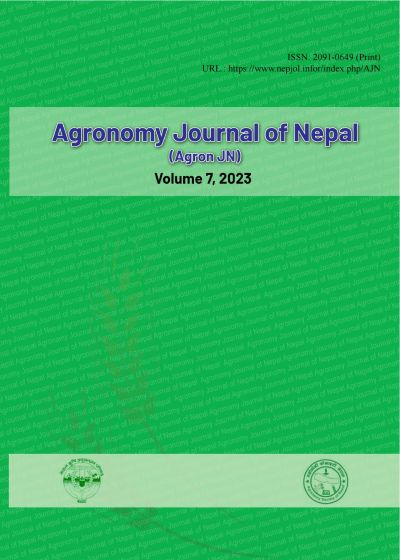Modified Nursery Structures: An Approach to Grow Rice Seedlings in Winter for Early Spring Planting
DOI:
https://doi.org/10.3126/ajn.v7i.62269Keywords:
Nursery beds, tunnel, spring rice, temperatureAbstract
Raising rice seedlings in cold winter months for subsequent early spring transplanting has a great challenge in rice-rice cropping system in Nepal. An essential technological intervention involves modifying the rice nursery structure to create an optimal environment that supports proper germination and seedling growth during the cold season. Hence, a field experiment was conducted to evaluate the impact of different nursery structures on the germination and growth of rice seedlings in the farmer’s field at Sunwal-12, Bhumahi, Nawalparasi West, from 21st of January- 19th of February, 2021, 2021. The experiment was executed in randomized complete block (RCB) design with 8 different raised bed (1m × 1m) structures as treatments, namely T1: open uncovered beds, T2: plastic tunnel covered beds, T3: mat bed under plastic tunnel, T4: plastic trayunder plastic tunnel, T5: Plastic tray under open condition, T6: Open bed with removal of dew, T7: Ash covered beds and T8: Plastic sheet covered beds. Each treatment was repeated three times. The spring rice variety Chaite-5 was sown at the rate of 60 g m-2, with dry seeds being evenly distributed in rows spaced 10 cm apart. The beds were fertilized at the rate of 1 kg N, 0.8 kg P2O5 and 0.8 kg K2O 100 m-2. Soil temperatures at a depth of 5 cm were monitored regularly at two time points each day, specifically at 8 am and 4 pm, until 30 days after sowing (DAS). The results revealed that the germination index, average height, and above ground weight were significantly higher (40.57, 9.81 cm and 78.67 gm-2, respectively) for the beds under tunnel (T2). Seedlings grown in trays under tunnel exhibited statistically similar plant heights. The highest seedling population m-2 (288% more compared to open beds) was obtained in trays (both open and under tunnel). Trays and mat beds under tunnel recorded higher soil temperature in the morning and evening, as well as higher air temperatures and relative humidity. These favorable conditions were met approximately 16-17 days earlier compared to the uncovered beds. Therefore, the practice of covering seedling beds with plastic tunnels, growing rice seedlings in plastic trays and utilizing mat beds were the better ways for raising rice seedlings in cold environments for early spring transplanting.
Downloads
Downloads
Published
How to Cite
Issue
Section
License
Copyright (c) 2023 Agronomy Society of Nepal (ASoN)

This work is licensed under a Creative Commons Attribution-NonCommercial 4.0 International License.
ASON permits for free use, distribution and reproduction in any medium if the original work is properly cited and not used for commercial purposes.




